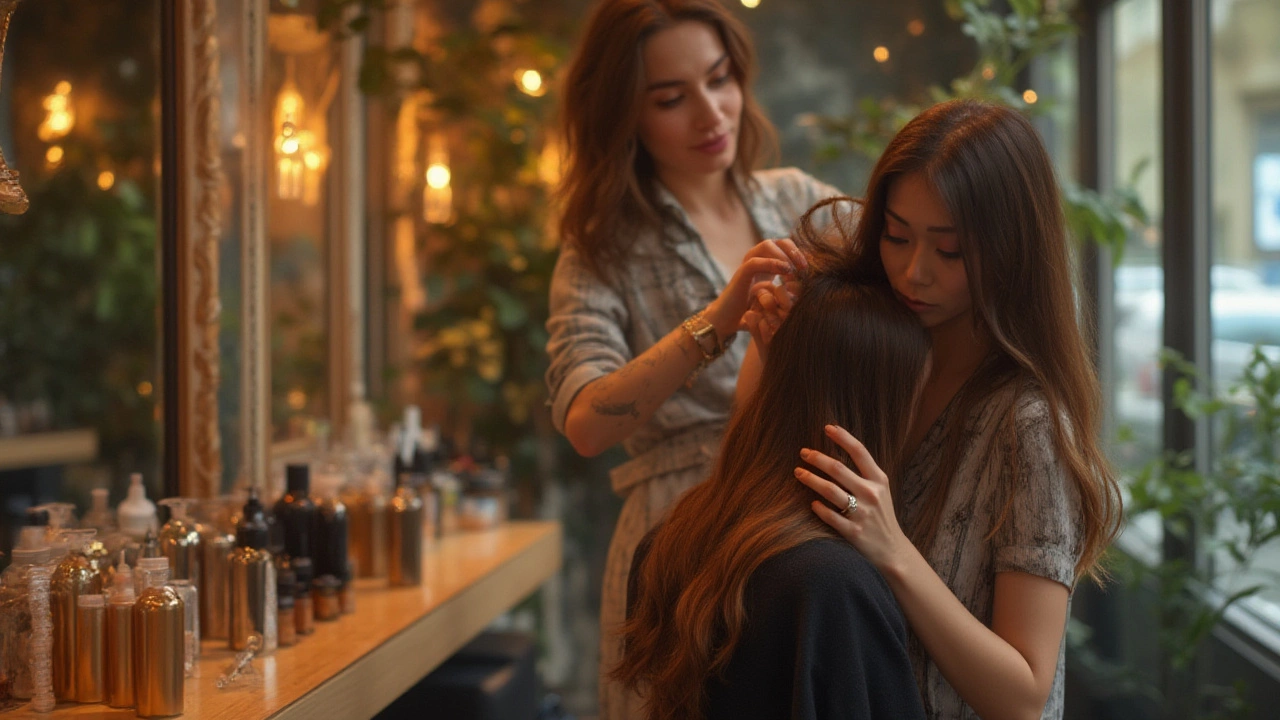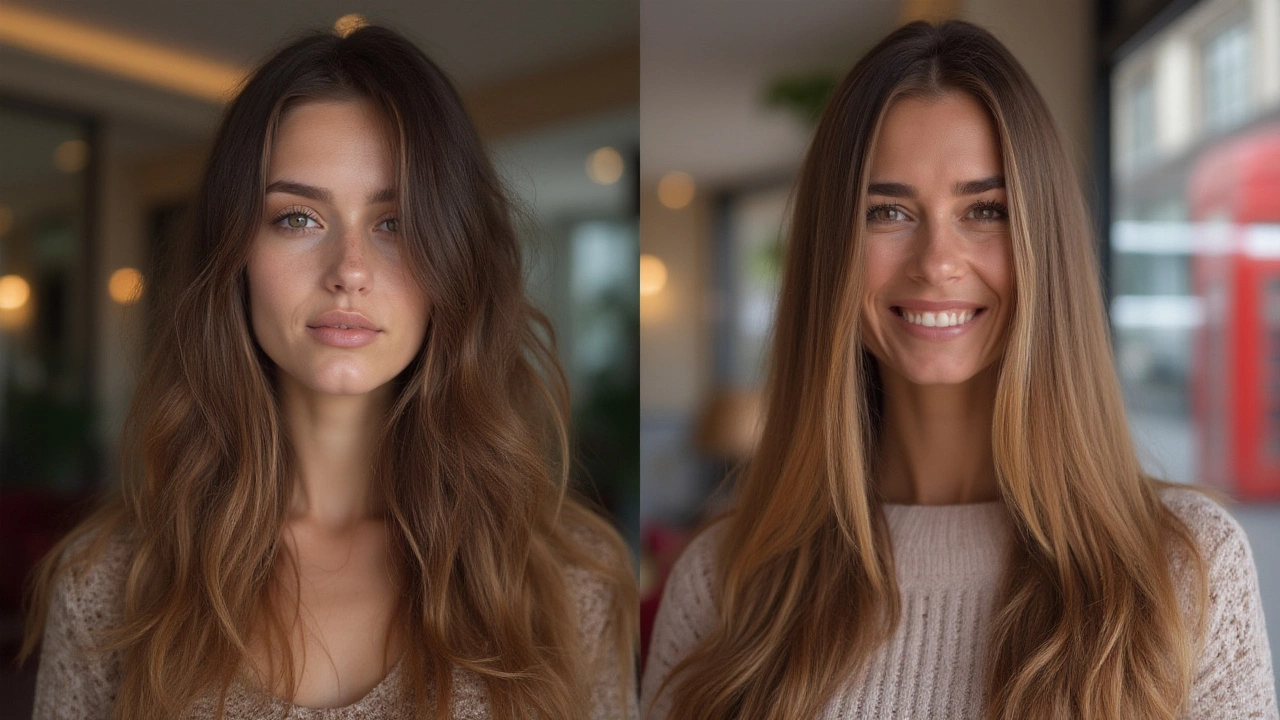
Your hair swishes like silk the moment you leave your hairdresser’s chair. But why does it never feel quite the same when you try to recreate that softness at home with your own products? Turns out, there’s a wild mix of chemistry, technique, and pro-level pampering behind that glossy, touchable hair. From secret sprays to clever serums, salons have their own toolkit of magical tricks—some of which you can borrow for yourself.
What’s Really in Those Salon Silkening Potions?
The list of professional hair potions is longer than a Friday evening queue at the blow-dry bar. Top salons don’t just use fancy bottles; they rely on products loaded with ultra-smoothing ingredients. Let’s get specific—most pro silkening sprays and serums have a high concentration of silicones like dimethicone and cyclopentasiloxane. These form a light layer around each strand, locking in moisture and giving that glassy shine you can spot a mile away. But it’s not just about the silicones. Professional conditioners often come packed with hydrolyzed silk or keratin, both proteins that patch up the hair cuticle. Think of them as filling in the potholes on the hair’s surface so light reflects perfectly, just like glass.
Some pro brands, like Redken or Kérastase, add amino acids and panthenol, which bind water inside the hair, keeping it hydrated long after your wash. When stylists want to pull out the big guns, they’ll use leave-in sprays that blend silicones, humectants, and conditioning agents like cetrimonium chloride, which makes hair feather-soft but not greasy. A stylist in a London salon once told me, “If you want that real silk effect, layer products: start with a hydrating mask, use a weightless leave-in mist, then finish with a pea-sized anti-frizz oil.”
Worth noting: hairdressers avoid heavy wax-based products—they weigh down strands and make hair look limp. Instead, they favor lightweight, buildable products that deliver gloss without grease. Ever heard of ‘lamellar water’? It’s becoming a salon staple. Unlike traditional conditioners, it uses liquid micro-layers to target damaged areas and leave hair super-sleek in just ten seconds. A 2024 survey found 67% of stylists now use some form of lamellar treatment in their after-wash routines.
But what about those famous glass-like finishes? That comes from heat-activated serums and sprays. Most are loaded with heat-protectants and smoothing silicones. So, when your stylist runs that flat iron or blow-dryer over your hair, these ingredients melt into the cuticle, sealing it tight. The result: crazy-silky hair that feels like you’ve just unwrapped a ribbon.
| Popular Salon Ingredients | Main Function |
|---|---|
| Dimethicone | Smoothing & gloss; locks in moisture |
| Hydrolyzed Keratin | Repairs damage, strengthens strands |
| Amino Acids | Deep hydration & flexibility |
| Cetrimonium Chloride | Conditioning, detangling |
| Lamellar Water | Surface smoothing in seconds |
| Panthenol (Vitamin B5) | Boosts moisture retention |
| Cyclopentasiloxane | Lightweight shine, easy spread |
Ever wonder why home conditioners don’t quite do the job? Pro products come with a much higher concentration of active ingredients, thanks to salon regulations and costs. You’ll often pay more, but even a small amount makes a big impact—that’s why stylists tell you to use just a coin-sized dab. Silky hair isn’t all about the product, though. It’s how it’s used, too. But more on that next.

It’s Not Just Products—It’s the Hairdresser’s Hands
Okay, so now you know the formulas. But there’s another secret: the way the product gets into your hair. Salon staff aren’t just slapping a conditioner on and hoping for the best. There’s a method to the pampering madness. First, stylists never skip the “double cleanse”—they wash twice using a clarifying shampoo before conditioning. Why bother? The first wash lifts out dirt and oil, making the second wash way more effective at prepping your hair to absorb those powerhouse actives. At home, most people rush the process, but in salons, it’s like a spa day for your scalp.
After rinsing out foam, stylists use pro tricks like towel blotting instead of harsh rubbing. Water weighs hair down, so gently squeezing with a microfiber towel stops breakage and keeps strands flat and neat—a must for a silky finish. Next step: conditioner applied root to tip, then combed through carefully with a wide-tooth comb or even their fingers. Every strand gets a coating. Some salons use steam hoods or warm towels to help the conditioner go even deeper into the hair shaft. If you’ve ever wondered why your own hair mask isn’t working miracles, skipping this heat step might be why.
Blow-drying is a real art. Hairdressers use a round brush, aiming the dryer downward along the cuticle. This matters—if the cuticle lays flat, light bounces off, and that’s what gives hair that mirror-like shine. Using a concentrator nozzle on the dryer helps keep the airflow focused so nothing goes frizzy.
Heat tools, like flat irons and curlers, aren’t just used for curl or shape—they’re magic for sealing in serums and smoothing sprays, too. Pro tip: hairdressers wait until hair is 90% dry before they even think about using a straightener or heated brush. And before any of that heat touches your hair, in goes a protective spray to stop the cuticle from frying or lifting. “You have to respect the cuticle,” says celebrity stylist Sally Brooks.
“Cuticle care is the secret to shine. If it’s smooth, your hair looks like glass. Open cuticles scatter light and make hair look dull or rough.”
Finishing touches? You’ve seen that quick flip and shake your stylist does before you leave—the magic’s not just for drama. A tiny drop of lightweight oil (like argan or camellia) gets worked into the ends. That’s not just for shine, it helps seal the cut ends and stop static. Some stylists add a last spritz of shine spray or mist for serious gloss. One London salon even swears by a trick: a single drop of silicone serum between the palms, then lightly pressing over the top layer of hair to tame flyaways and boost gloss for photos. You can try this yourself for big event hair that absolutely swishes.
The difference at the salon? It’s never just one thing—it’s product, process, and a trained hand, working together. At home, you can adopt a few of these methods. Try double-cleansing, towel-blotting, using a wide-tooth comb in the shower, and drying downward. Even using a little heat (and a lot of heat protection) can give you that professional gleam.

Salon Secrets You Can Actually Use at Home
You don’t need a weekly appointment or an endless supply of pro bottles to score soft, glossy hair yourself. Salons might have the upper hand, but there are tricks you can steal for home. Start with your wash routine. Shelve harsh, stripping shampoos unless your scalp is super oily, and opt for sulfate-free or gentle cleansers that won’t rough up your hair’s cuticle. When you use conditioner, don’t rush. Comb it through gently and leave it on for a few minutes—longer if your hair’s thirsty from color or heat.
Consider investing in a silk-infused or keratin conditioner for a real texture boost; these aren’t just buzzwords—formulations with hydrolyzed proteins and amino acids fill in each strand, making hair not just shiny but genuinely smoother to the touch. Weekly deep-conditioning treatments work wonders if your hair’s been fried by sun, salt, or styling tools. Here’s another little-known hack: rinse your hair with cool water at the end of showering. This snaps your cuticles shut and makes your hair gleam, just like after a professional blowout.
Speaking of blowouts, you can mimic a salon finish with a good round brush, a solid (not too heavy) blowdryer, and plenty of patience—drying in small sections is key. Don’t forget the heat protectant spray, especially if you color or bleach. Oiling your hair sounds intimidating, but even a single drop of lightweight oil smoothed through mid-lengths and ends adds instant silkiness. If you have fine hair, try a silicone-free shine spray, or a tiny amount of serum—a little goes a long way, and it washes out without buildup.
Want to amp things up even further? There are in-shower lamellar water treatments on store shelves now (like L’Oréal’s Wonder Water) that work in under a minute and leave you with finger-slip softness. Another biggie: microfiber towels or old cotton T-shirts for squeezing out water—never rub, it just roughs up the cuticle. And swap your cotton pillowcase for silk. Less friction means less frizz, and you’ll notice in the morning your hair isn’t a tangled mess.
If you’re on a budget, mix 2 teaspoons of coconut oil with a tiny splash of aloe gel for a pre-wash mask—leave it for 30 minutes before shampooing. It helps patch up the cuticle and gives a smoother finish when you style. Or grab a small bottle of argan oil and use a single drop as a shine finisher. You really don’t need much—too much oil will flatten and grease up your hair, missing the glossy effect you’re after.
Keep in mind, though, if your hair’s damaged from coloring or heat, nothing’s going to make it magically silk-like overnight. Products can fake smoothness, but real health takes time. Trim split ends often, deep-condition weekly, and protect hair on hot or sunny days. It’s slow progress, but week by week, you’ll see the shine and silkiness come back.
Here’s a tip salon pros wish you knew: never use more product “just in case.” Start with less, smooth it through, then build as needed. And don’t overload with different formulas—sometimes, simple layering works better than a mountain of heavy creams and oils. “It’s all about choosing what your hair needs in the moment,” stylist Armin Morbach told Allure last year. “Listen to your hair, don’t smother it.”